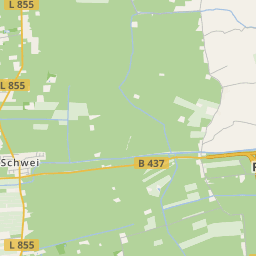











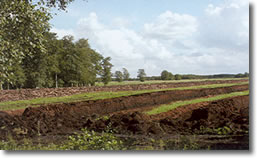
Expansive green land traversed by countless trenches, marsh farms with lots of trees and grazing cows characterise the Wesermarsh's picture. The Wesermarsh behind the dikes offers the viewer unique nature and culture countryside.
Just before Butjadingen's dikes the Nationalpark 'Lower Saxon mudflat' begins.
It extends in front of the whole of the Lower Saxony coast and encompasses Watt (mudflats) and tidal creeks, salt meadows, dunes, beaches and sandbanks. Twice daily the curtains goes up for nature's play of low and high tide. The mudflats are flooded by the North Sea, which is withdrawing by low tide. Walking on the ocean grounds...
an unforgettable experience at the North Sea and the Jade Bight! Low tide is the time to tour the mudflat with an experienced mudflat-guide. You will walk barefoot through the mudflat, feel the riffles created by the waves on the ocean ground, wade through small tidal creeks and learn about the thrilling mudflat and its inhabitants.
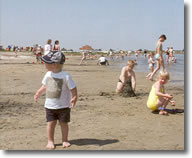
At the Unterweser and peninsula Butjadingen you will find lovely sand and green beaches for swimming fun during the summer. At the Weser islands Harrier-
sand, Elsflether Sand, Warflether Sand and Strohauser Plate as well as the lush marsh and bog meadows you can watch unique birds for instance peewits, black-tailed godwits and redshanks.
Nature preservation and farming have been going hand in hand in partnership. The landscape conservation area Strohauser Plate is a valuable refuge for rare birds and plants.
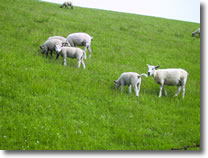
The rhythm of the tides affects not only the life of the birds but also that of the people along the North Sea coast. Enormous green banks shield the flat marsh land from the floods. During the summer an army of sheep lives on the dikes who will take care of the dike stability as 'scuttle roll'. Different dike sheep-farms in the Wesermarsch can be visited and there one gets information about sheep farming. In Rodenkirchen Absen is the oldest still original preserved dike opening.
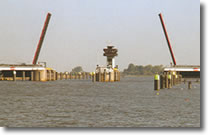
Apart form the numerous sluices for irrigation and drainage there are also coastal pumping station in the Wesermarsh and an endless and sophisticated network of sluice deeps and tension ditches. Without those the Wesermarsh would be flooded twice daily. Impressive buildings like the Elsflether Hunte-barrage, the Ochtum or Lesum-barrage protect the people in the region from the water masses since 1979.
Comfort for the soul of the recreation seeker is the bog landscape: The Gellener Moor with its high moor areas and fish ponds distinguishes itself through rarity and special beauty. On the signposted nature trail of the nature protection area "Gellener Torfmöörte" on gets to know about the biodiversity of the typical fauna and flora. Near Sehestedt the outside of the dike situated worldwide unique 'Swimming Moor' is an attraction of a very special kind. Here one can also learn about the feature of the salty meadows on a nature trail. Further south near Schweiburg you can experience the change from moor to marsh.